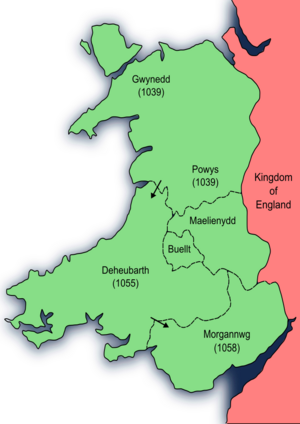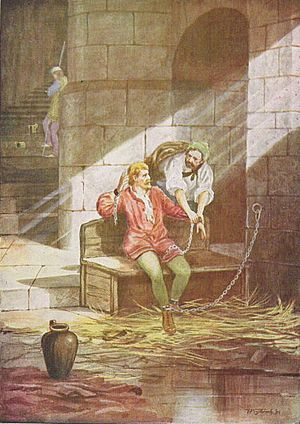Wales in the High Middle Ages facts for kids
Wales in the High Middle Ages is a time in Welsh history from the 11th to the 13th centuries. It starts just before the Normans arrived in the 1060s and finishes with King Edward I taking control of Wales between 1278 and 1283. This was a time of big changes for Wales in its government, culture, and how people lived.
Contents
Welsh Rulers and Norman Challenges
One King for All Wales
For a short time, Gruffydd ap Llywelyn was the only ruler who managed to unite all of Wales under his control. In 1055, he defeated his rival, Gruffydd ap Rhydderch, and took back the kingdom of Deheubarth.
Gruffydd was originally the king of Gwynedd. By 1057, he ruled all of Wales and had even taken over some areas of England near the border. He ruled Wales peacefully, with no internal fights. After his death, his lands were divided again into the old kingdoms.
Historian John Davies said that Gruffydd was "the only Welsh king ever to rule over the entire territory of Wales." This means that from about 1057 until he died in 1063, all of Wales recognized Gruffydd ap Llywelyn as their king. For about seven years, Wales was united under one ruler, which had never happened before or since. During this time, Wales was at peace.
Normans Arrive in Wales
When the Normans conquered England in 1066, the most powerful ruler in Wales was Bleddyn ap Cynfyn. He was king of both Gwynedd and Powys. At first, the Normans were busy making their power strong in England. Historian Rees Davies said that Wales was "utterly peripheral to their ambitions," meaning it wasn't their main focus.
However, some Welsh leaders helped English rebels fight against Norman rule. This made the Normans turn their attention to Wales. The Normans first succeeded in the south. William FitzOsbern, 1st Earl of Hereford took over the Kingdom of Gwent before 1070. By 1074, the forces of the Earl of Shrewsbury were attacking Deheubarth.
When Bleddyn ap Cynfyn was killed in 1075, it led to a civil war in Wales. This gave the Normans a chance to take lands in northern Wales. In 1081, Gruffudd ap Cynan had just won the throne of Gwynedd. He was tricked into a meeting with the Earl of Chester and the Earl of Shrewsbury. They quickly captured and imprisoned him. This allowed the Normans to take much of Gwynedd.
Rhys ap Tewdwr of Deheubarth was killed in 1093. His kingdom was then taken and split among different Norman lords. It seemed like the Norman conquest of Wales was almost complete.
Welsh Fight Back
But in 1094, there was a big Welsh revolt against Norman rule. Slowly, the Welsh won back their lands. Gruffudd ap Cynan was eventually able to build a strong kingdom in Gwynedd. His son, Owain Gwynedd, joined forces with Gruffydd ap Rhys of Deheubarth. They won a huge victory over the Normans at the Battle of Crug Mawr in 1136 and took over Ceredigion.
Owain became king of Gwynedd the next year after his father died. He ruled until 1170. He was able to take advantage of a time of trouble in England, called the Anarchy. During this time, Stephen and the Empress Matilda were fighting for the English throne. This allowed Owain to expand Gwynedd's borders further east than ever before.
The Kingdom of Powys also had a strong ruler at this time, Madog ap Maredudd. But when he died in 1160, his heir, Llywelyn ap Madog, died soon after. Powys was then split into two parts and never became united again.
Norman England controlled much of the Welsh borders and the rich farming lands in the south. By the 12th century, this area became known as the Marches. The word "Marches" comes from a French word for a border. The uplands of Wales became known as Pura Wallia, meaning "Pure Wales." The Normans spoke Norman French. They brought English-speaking farmers to the lands they controlled and acted as rulers over them. King Henry I invited people from Flanders (now Belgium) to live in Pembrokeshire. They were fleeing floods in their homeland. There, they started a cloth-making business. We don't know exactly what happened to the local people when these new groups arrived. But writers from that time wrote about tensions and conflicts between different groups. A century later, Llywelyn ap Iorwerth (Llywelyn the Great), a Prince of Gwynedd, attacked the area and killed many of the Flemish people.
In the south, Gruffydd ap Rhys was killed in 1137. But his four sons, who each ruled Deheubarth in turn, were eventually able to win back most of their grandfather's kingdom from the Normans. The youngest of the four, Rhys ap Gruffydd, ruled from 1155 to 1197. In 1171, Rhys met King Henry II and made an agreement. Rhys had to pay a tribute (a payment to the king), but in return, he was allowed to keep all the lands he had conquered. He was later named the Justiciar of South Wales, which meant he was a chief judge and administrator. Rhys held a special event of poetry and song at his court in Cardigan over Christmas in 1176. This is usually seen as the first recorded Eisteddfod, a famous Welsh festival. Owain Gwynedd's death led to Gwynedd being split among his sons. For a time, Rhys made Deheubarth the most powerful kingdom in Wales.
Llywelyn the Great and Llywelyn the Last
From the power struggles in Gwynedd came one of the greatest Welsh leaders, Llywelyn ab Iorwerth. He was also known as Llywelyn Fawr (the Great). By 1200, he was the sole ruler of Gwynedd. By the time he died in 1240, he was effectively the ruler of much of Wales. Llywelyn made his main home and center of power at Abergwyngregyn on the north coast, looking out over the Menai Strait.
In 1200, Llywelyn the Great became King of Gwynedd. He agreed to a peace treaty with King John of England and married King John's daughter, Joan. In 1208, Llywelyn claimed the Kingdom of Powys. This happened after Gwenwynwyn ap Owain, the ruler of Powys, was arrested by King John. King John didn't like Gwenwynwyn's attacks on the Norman lords in the south.
King John gained more control over Wales. In 1211, he took Llywelyn the Great's son, Gruffydd ap Llywelyn, as a hostage. He also forced Llywelyn to give up land in northeast Wales. Llywelyn's son and other Welsh hostages were held by the king as a guarantee. However, the Welsh and Scots joined English rebel lords in forcing King John to sign the Magna Carta in 1215. This important document included specific rules for the Welsh. It said that lands and freedoms should be returned to Welshmen if they had been taken by English people without a fair judgment. It also demanded the immediate return of Gruffydd and the other Welsh hostages.
Llywelyn went on to gain control over all of Wales the next year. In 1218, after King John died, Llywelyn and King Henry III agreed to the Treaty of Worcester. This treaty again confirmed Llywelyn's right to rule Wales until his death in 1240.
His son, Dafydd ap Llywelyn, became the ruler of Gwynedd after him. But King Henry III of England would not let Dafydd inherit his father's power over the rest of Wales. War broke out in 1241. On August 29, 1241, under the Treaty of Gwerneigron, Dafydd gave up all his lands outside Gwynedd. The conflict started again in 1245. It was still ongoing when Dafydd suddenly died at Abergwyngregyn in early 1246, without leaving an heir. Llywelyn the Great's other son, Gruffudd, had been killed trying to escape from the Tower of London in 1244. Gruffudd had left four sons. A period of fighting among three of these sons ended with Llywelyn ap Gruffudd becoming powerful. He was also known as Llywelyn Ein Llyw Olaf, which means Llywelyn, Our Last Leader.
The Treaty of Montgomery in 1267 confirmed that Llywelyn had direct or indirect control over a large part of Wales. However, King Edward I didn't like Llywelyn's alliance with Simon de Montfort. Simon de Montfort had rebelled against the English king in a war between 1264 and 1267. This led to war in 1277. Llywelyn had to agree to terms, and the Treaty of Aberconwy greatly limited his power.
War broke out again when Llywelyn's brother, Dafydd ap Gruffudd, attacked Hawarden Castle in 1282. On December 11, 1282, Llywelyn was tricked into a meeting in Cilmeri, near Builth Wells. He was killed there, and his army was then destroyed. His brother Dafydd ap Gruffudd continued to resist, but it was a losing battle. He was captured in June 1283 and was executed in Shrewsbury. This ended Welsh independence. Wales effectively became England's first colony until it was formally joined with England through the Laws in Wales Acts 1535-1542.
See also




